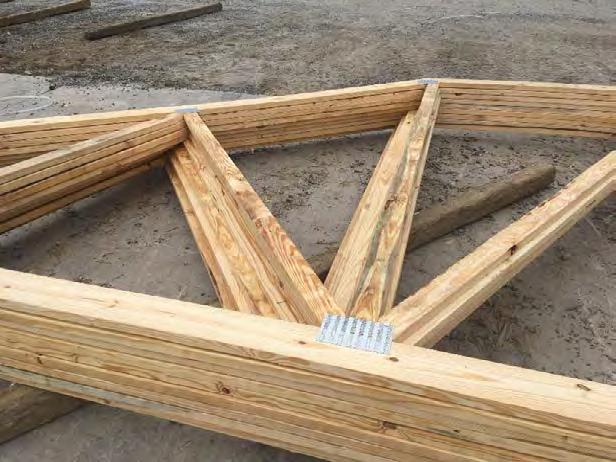
3 minute read
Are Your Deliveries Making the Right Impression?
So you won the order. Congratulations. The designs and the submittals were approved. Sounds great. The trusses were built with care and meet all of the necessary requirements. Awesome! Does it stop here? No, not really. The customer has not had a chance to really get a rock-solid impression. Based on the process to this point it might be great, but there is another hurtle. What’s that? We are glad you asked.


It’s the presentation. That’s right. The deal was closed based on perceptions and assumptions, but the deal is not consummated until the trusses hit the job. It’s probably one of the most crucial elements of the transaction, but unfortunately it’s often overlooked. There are several things a fabricator can do to clinch his relationship with the client. While some manufacturers take special care to line up their product, using special care to align trusses is something most fabricators do not.

The trusses in these photos are of the same truss profiles. They are long trusses and were difficult to handle by the stacker.
The trusses, just after this photo, were banded together and marked with their job number. This will be what the builder sees when it hits his jobsite. The trusses look erratic, irregular, and dissimilar. They were built in the same jigging and “probably” are the same. I say probably, because the haphazard stacking makes the trusses look to be varying. The trusses appear to lack any obvious principle of organization. This is the impression the erection contractor will have as soon as he drives up onto his jobsite. Their impression will be negative. Even if the trusses were exactly identical, the contractor, in the back of his mind, will have the impression the trusses vary. This first impression will be very hard to improve. Subliminally the impression will remain with the witness. It will always be a part of their impression of this order. Your order. Your reputation.
Is there a better way to deal with this concern? Yes, but it might take a short introduction for users not accustomed to this method. The recommendation is to add two 10d brite nails to each truss at the overhand into the truss below.
1. This will help the stacker maintain a straight pack even as they draw another truss over.
2. The nails will help prevent trusses from slipping within their banding.
3. Nails will help the banding do a better job.
4. Visually aligning trusses will help identify mis-fabricated trusses before they are shipped.
5. Alignment helps ensure uniformity and improve the resulting impression.
This will help the stacker maintain a straight pack even as they draw another truss over . The nails will help prevent trusses from slipping within their banding. Nails will help the banding do a better job. V isually aligning trusses will help identify mis-fabricated trusses before they are shipped. Alignment helps ensure uniformity and improve the resulting impression.
Make sure to use brite nails. Not cement coated or ringshank. These are difficult for the field to remove as they are swinging the trusses. Initially the field might be a little aggravated, however, they will grow accustomed to doing this over time and it won’t present an issue. The result will be a better first impression, and less call backs and issues with the probing of your quality.
An ANSI/TPI 1 3rd Party Quality Assurance Authorized Agent covering the Southeastern United States, Glenn Traylor is an independent consultant with almost four decades of experience in the structural building components industry. Glenn serves as a trainer-evaluator-auditor covering sales, design, PM, QA, customer service, and production elements of the truss industry. He also provides project management specifically pertaining to structural building components, including on-site inspections and ANSI/TPI 1 compliance assessments. Glenn provides new plant and retrofit designs, equipment evaluations, ROI, capacity analysis, and CPM analysis.










